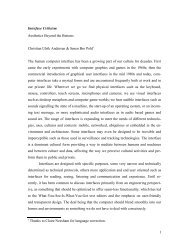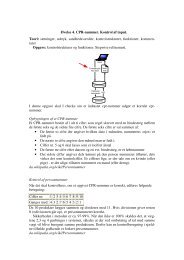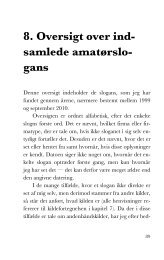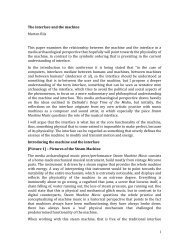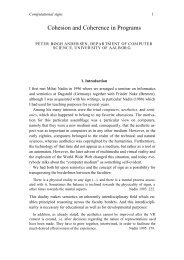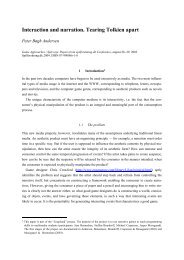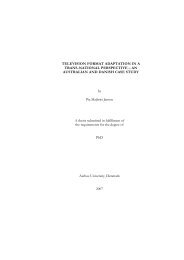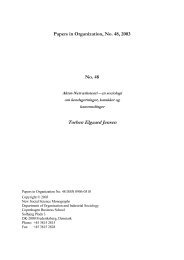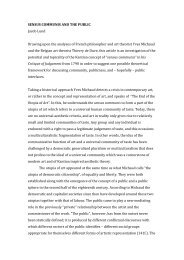You also want an ePaper? Increase the reach of your titles
YUMPU automatically turns print PDFs into web optimized ePapers that Google loves.
<strong>Maneuvering</strong> <strong>the</strong> <strong>Sally</strong> <strong>Maersk</strong>M O R T E N N I E L S E NCenter for Human-Machine Interaction. Report CHMI-3-2000
Table of contentsIntroduction ...................................................................................................................3Steering..........................................................................................................................3Follow up steering.....................................................................................................4Auto Pilot ..................................................................................................................7Voyage Management System..................................................................................10The passage plan .................................................................................................10System modes......................................................................................................11<strong>Maneuvering</strong> characteristics........................................................................................12Propulsion....................................................................................................................13Acceleration.............................................................................................................13Deceleration.............................................................................................................16Thrusters..................................................................................................................172
MANEUVERING THE SALLY MÆRSKIntroductionBasically <strong>the</strong> movements of a seagoing vessel—its maneuvers—are determined by<strong>the</strong> interaction between controllable and uncontrollable physical forces. Thus, fromthis perspective safe and timely maritime operations are a matter of applying <strong>the</strong>controllable forces on <strong>the</strong> uncontrollable forces in a way that results in <strong>the</strong> desiredmovements.Controlable forcesEngineRudderThrusterAnchorTugHawserUncontrolable forcesWindCurrentSwellSeaSuction effectBank effectFigure 1. The Controllable and uncontrollable forces involved in maneuvering a seagoing vessel.The present report presents <strong>the</strong> controllable forces available to <strong>the</strong> crew of <strong>the</strong><strong>Sally</strong> Mærsk during at-sea maneuvers. Focus will be on steering and propulsion, thatis, <strong>the</strong> rudder and its control systems and <strong>the</strong> propulsion system driving <strong>the</strong> vessel.Steering<strong>Sally</strong> Mærsk is fitted with a streamlines semi spade-type balanced rudder. Themassive 100m 2 rudder is mounted on a vertical rudder stock which is turned by fourelectro-hydraulic cylinders. The maximum rudder angle 'hard over' to port orstarboard is 35°.As seen from <strong>the</strong> perspective of <strong>the</strong> actor on <strong>the</strong> bridge of <strong>the</strong> vessel <strong>the</strong> steeringgear is an object to be controlled with <strong>the</strong> purpose of achieving certain movements of<strong>the</strong> vessel. In order to facilitate different modes of interaction with <strong>the</strong> steering gearan elaborate control system has been placed between <strong>the</strong> actor and <strong>the</strong> steering gear.The purpose of <strong>the</strong> following is to illustrate how <strong>the</strong> rudder is operated in <strong>the</strong> contextof maneuvering ra<strong>the</strong>r <strong>the</strong>n explicating in detail <strong>the</strong> engineering details of <strong>the</strong> steeringsystem. To this end we will consider <strong>the</strong> physical steering gear (rudder blade, rudderstock, cylinders, etc.) <strong>the</strong> object of control, while <strong>the</strong> system in-between <strong>the</strong> humanactor and <strong>the</strong> actual steering gear will be understood as <strong>the</strong> control system. Our3
purpose is to explicate <strong>the</strong> control system in order to provide an understanding of <strong>the</strong>possible ways of maneuvering <strong>the</strong> vessel.The steering control system fitted on <strong>the</strong> <strong>Sally</strong> Mærsk is a Sperry Adaptive DigitalGyropilot ADG 6000. The system facilitates five different modes of steering:A. Fully automatic. The voyage management system provides <strong>the</strong> auto pilot withcourse information.B. Auto pilot. The course to be followed is set by a human actor and <strong>the</strong> auto pilotfollows <strong>the</strong> given courseC. Follow up. The human actor turns <strong>the</strong> steering wheel to a rudder setting(rudder angle) and <strong>the</strong> control system moves <strong>the</strong> rudder to <strong>the</strong> desired position.D. Non follow up. The human actor moves <strong>the</strong> rudder via a direct link to <strong>the</strong>cylinders turning <strong>the</strong> rudder. The rudder only moves as long as <strong>the</strong> switch ispressed to ei<strong>the</strong>r starboard or port.E. Telephone. An actor on <strong>the</strong> bridge communicate desired rudder setting viatelephone to an engineer who operates <strong>the</strong> rudder from <strong>the</strong> emergency stand.The emergency stand functions according to <strong>the</strong> principle of non follow up.The five different modes of steering represent different levels of automationavailable within <strong>the</strong> steering control system. To understand <strong>the</strong> use objective of <strong>the</strong>different modes of maneuvering we must distinguish between <strong>the</strong> objectives ofrobustness and maneuverability. Not all modes have been implemented strictly inorder to provide better opportunities for maneuvering. This is <strong>the</strong> case for both <strong>the</strong>telephone mode and non follow up. There simply is no motivation for <strong>the</strong>se modes ifwe consider <strong>the</strong>m exclusively in terms of maneuvering. They are however perfectlysensible as measures of robustness. The fully automatic mode, <strong>the</strong> auto pilot, andfollow up mirror <strong>the</strong> nature of different types of maneuvering while <strong>the</strong> lower levelsof automation are measures counteracting a total loss of steering if <strong>the</strong> higher levelsof automation fail. The counter measures to system failure can be traced even fur<strong>the</strong>rto <strong>the</strong> mountings on <strong>the</strong> rudder stock allowing it to be turned by chains, and so forth.However, to understand how <strong>the</strong> actors maneuver <strong>the</strong> vessel we may concentrateexclusively on <strong>the</strong> three topmost levels of automation as <strong>the</strong>se are <strong>the</strong> modes usedduring standard operations.The different modes of steering are performed by use of dedicated devices. In <strong>the</strong>above we have already mentioned <strong>the</strong> vessel management system and <strong>the</strong> auto pilotbeing two such effectuators. In <strong>the</strong> below we will deal with <strong>the</strong>se and fur<strong>the</strong>r controlsubsystems in more detail. We will explain <strong>the</strong>ir basic functioning and illustrate how<strong>the</strong>y serve different types of maneuvering. We will start with <strong>the</strong> helm stand and <strong>the</strong>o<strong>the</strong>r effectuators that are in use during follow up maneuvering.Follow up steeringWhen operating in open water, say, when crossing <strong>the</strong> Atlantic Ocean, <strong>the</strong> vesselfollows <strong>the</strong> same course for long periods of time. Space is ample and <strong>the</strong> need forrash course changes seldom occurs. However, <strong>the</strong> conditions change radically whenoperating closer to a harbor where traffic density is high and <strong>the</strong> space (restricted bywater depth and traffic regulations) is limited. In <strong>the</strong> latter case maneuvering is mostoften performed manually, for example, by a helmsman steering <strong>the</strong> vessel manuallyfrom <strong>the</strong> helm stand.4
Figure 2. Helm standThe rudder moves when <strong>the</strong> wheel on <strong>the</strong> helm stand is turned. Yet <strong>the</strong> wheel canbe turned significantly faster than <strong>the</strong> hydraulic pumps can turn <strong>the</strong> rudder. Thus,when changing <strong>the</strong> setting of <strong>the</strong> rudder from, say, amidships to hard a port it willtake a moment before <strong>the</strong> actual rudder angle equals <strong>the</strong> desired rudder angle set on<strong>the</strong> helm stand.The helm stand holds a number of indicators. The desired rudder angle (<strong>the</strong> angleset by <strong>the</strong> helmsman) is engraved on a scale just above <strong>the</strong> base of <strong>the</strong> axle holding<strong>the</strong> wheel, and it is also displayed on <strong>the</strong> electronic helm order indicator. The rounddisplay at <strong>the</strong> center of <strong>the</strong> stand is a gyrocompass indicating <strong>the</strong> present course. To<strong>the</strong> left of <strong>the</strong> compass is a rudder indicator (actual rudder angle), and to its right is arate of turn indicator (displaying rate of turn measured in degrees per minute).The helmsman is in hands on control of <strong>the</strong> wheel on <strong>the</strong> helm stand, while <strong>the</strong>settings to be implemented are decided by <strong>the</strong> master or <strong>the</strong> pilot and communicatedorally to <strong>the</strong> helmsman. The helmsman acts on two basic type of commands: ruddercommands and course commands. Rudder commands have <strong>the</strong> form 'ten degreesstarboard' while a course command could be 'go to two two five' (two hundred andtwenty five degrees). The rudder command is implemented by turning <strong>the</strong> wheel on<strong>the</strong> helm stand to starboard until <strong>the</strong> helm order indicator reads 10°.Course commands are more complex. They demand a higher level of skill on <strong>the</strong>part of <strong>the</strong> helmsman and <strong>the</strong>y demand his attention for longer periods of time: first<strong>the</strong> helmsman changes <strong>the</strong> course (indicated on <strong>the</strong> compass) according to <strong>the</strong>command and <strong>the</strong>n he performs continuos adjustments (counteracting wind, swell,current, etc.) to <strong>the</strong> rudder setting in order to maintain <strong>the</strong> commanded course.5
Figure 3. Displays on <strong>the</strong> helm stand: gyrocompass at <strong>the</strong> center, rudder angle indicator to its left, rateof turn indicator to is right. Helm order indicator is positioned below <strong>the</strong> compass.Finally, <strong>the</strong> helmsman may be asked to perform a specific rate of turn, say, 'keepher at ten degrees rate of turn'. Normally, a rate of turn command will be given whena turn is already in progress and <strong>the</strong> objective is to have <strong>the</strong> helmsman maintain <strong>the</strong>present rate of turn. He does so by means of <strong>the</strong> wheel and <strong>the</strong> rate of turn indicator.Figure 4. Dial for setting <strong>the</strong> rudder angle.The bridge holds three o<strong>the</strong>r actuators used for manual steering of <strong>the</strong> vessel <strong>the</strong>yall look like one shown in figure 4. One is positioned on <strong>the</strong> central console on <strong>the</strong>center bridge, and <strong>the</strong> o<strong>the</strong>r two are located on <strong>the</strong> consoles in <strong>the</strong> starboard and portbridge wing. The steering control in <strong>the</strong> bridge wings are used exclusively by <strong>the</strong>master during mooring maneuvers, and <strong>the</strong> actuator on <strong>the</strong> center bridge is used by<strong>the</strong> master and officers during manual steering in coastal waters.6
Auto PilotThe auto pilot is capable of maintaining a heading which is fed to it manually by <strong>the</strong>navigating crew or automatically by <strong>the</strong> voyage management system. The latter casewill be dealt with in <strong>the</strong> section concerned with <strong>the</strong> voyage management system, in<strong>the</strong> present section we will describe <strong>the</strong> auto pilot as it functions when <strong>the</strong> course isentered manually.Figure 5. Auto pilotThe auto pilot's interface is composed of a left, right, and mid section. At <strong>the</strong> topof <strong>the</strong> center section (figure 5) is <strong>the</strong> rate of turn indicator reading <strong>the</strong> vessels presentrate of turn to starboard or port. Below <strong>the</strong> rate of turn indicator is <strong>the</strong> heading display(gyrocompass repeater) reading <strong>the</strong> present heading. The mode display reading <strong>the</strong>mode settings is located to <strong>the</strong> left of <strong>the</strong> heading display, and to its right is <strong>the</strong> courseorder dial (used for setting <strong>the</strong> desired course) and <strong>the</strong> course order display (reading<strong>the</strong> ordered course).Figure 6. The top section of <strong>the</strong> auto pilot: <strong>the</strong> rate of turn indicator at <strong>the</strong> top, below it is <strong>the</strong> headingindicator (gyrocompass repeater). To <strong>the</strong> left of <strong>the</strong> heading display is <strong>the</strong> mode display reading <strong>the</strong>mode setting, and to <strong>the</strong> right of <strong>the</strong> heading display is <strong>the</strong> course order dial (used for setting <strong>the</strong>ordered course) and <strong>the</strong> course order display.The below five figures (7-11) show <strong>the</strong> components positioned in a vertical line at<strong>the</strong> right side of <strong>the</strong> auto pilot. System (figure 7) displays <strong>the</strong> setting of <strong>the</strong> interactive7
system display (figure 11). The labels PORT and STARBOARD in figure 11 refer to <strong>the</strong>two set of hydraulic pumps turning <strong>the</strong> rudder.Figure 7. Figure 8. Figure 9. Figure 10. Figure 11.Elsewhere, <strong>the</strong> actor can determine if one or both sets of pumps are on; if only oneset is on <strong>the</strong>n <strong>the</strong> setting of <strong>the</strong> system dial (figure 11) determines which set of pumps(starboard or port) should be activated. Figure 8 illustrates a set of dimmers whichallow <strong>the</strong> actor to adjust <strong>the</strong> light INTENSITY on <strong>the</strong> individual auto pilot displays(intensity is turned down during nighttime operations). The <strong>Sally</strong> Mærsk is fitted withtwo gyrocompasses. Figure 9 shows <strong>the</strong> dial determining which COMPASS is used as<strong>the</strong> source of course information (<strong>the</strong> o<strong>the</strong>r gyrocompass functions as a backup unit).The MODE dial (figure 10) plays an important role within <strong>the</strong> steering control system:<strong>the</strong> actor changes <strong>the</strong> steering mode (degree of automation) by turning this dial. Themodes NFU, HELM, AUTO (auto pilot), and NAV (fully automatic) where mentioned at<strong>the</strong> beginning of this chapter. The RMT (remote) setting changes control of steeringfrom <strong>the</strong> console on <strong>the</strong> central bridge to <strong>the</strong> steering console in port or starboardbridge wing. The procedure of switching between steering consoles is a two-stepoperation to ensure that only one steering console is active, and that <strong>the</strong> activeconsole is manned: first <strong>the</strong> mode dial is set to RMT, but <strong>the</strong> actual change of controllocation is not effectuated before <strong>the</strong> ACCEPT button in <strong>the</strong> port or starboard bridgewing has been pushed.Figure 12. Figure 13. Figure 14. Figure 15. Figure 16. Figure 17. Figure 18.The units on <strong>the</strong> right side of <strong>the</strong> auto pilot all have to do with parameters for <strong>the</strong>track following performed by <strong>the</strong> auto pilot. In order to perform satisfactory <strong>the</strong> autopilot needs information on <strong>the</strong> present WEATHER condition (figure 15) and <strong>the</strong> LOADcondition of <strong>the</strong> vessel (figure 18). The auto pilot is a means of maintaining a certaincourse automatically but it is also an effective means of optimizing <strong>the</strong> fuelconsumption while en route. The setting of <strong>the</strong> RUDDER dial (figure 16) limits <strong>the</strong>maximum rudder angle resulting in smooth curves. The TURN RATE dial has an8
identical function but <strong>the</strong> limitation is now expressed in a maximum turn rate allowedduring track following.The present setting of <strong>the</strong> dials are somewhat misleading because <strong>the</strong> pictureswhere taken just after having entered a harbor: <strong>the</strong> different parameters are set tohigher values in coastal waters in order to ensure responsive auto pilot maneuvering.On open water <strong>the</strong> parameters are set to more restrictive values (e.g. rudder 5, turnrate 10), thus ensuring a minimum degree of braking effect resulting from any ruddersetting o<strong>the</strong>r than amidships (neutral). The SPEED dial (figure 17) is always at maxbecause <strong>the</strong> speed of <strong>the</strong> vessel is never regulated from <strong>the</strong> auto pilot (see <strong>the</strong> chapteron propulsion). The AUTO/NAV dial (figure 13) is <strong>the</strong> central parameter involved inreducing <strong>the</strong> fuel consumption on open water: <strong>the</strong> AUTO/NAV dial allow <strong>the</strong> actor tospecify a certain tolerance within <strong>the</strong> track following function of <strong>the</strong> auto pilot.Setting <strong>the</strong> AUTO/NAV dial to 10° means that <strong>the</strong> auto pilot will not perform a coursecorrection until <strong>the</strong> vessel is more than 10° off <strong>the</strong> ordered course. Combine thisfeature with limitations on rudder angle and rate of turn and <strong>the</strong> result is a smoothtrack with few rudder alterations. The steering parameters can however become torestrictive in certain cases, say, if <strong>the</strong> vessel enters an area with strong cross current orwind which means that <strong>the</strong> auto pilot is unable to perform <strong>the</strong> desired course. In suchcases <strong>the</strong> auto pilot will sound an alarm and <strong>the</strong> little lamp at <strong>the</strong> top of <strong>the</strong> AUTO/NAVsection (figure 13) will switch on. It is <strong>the</strong>n up to <strong>the</strong> navigating officer to ensure thatappropriate parameter tuning is achieved before <strong>the</strong> vessel comes too far off course.The ALARM section (figure 12) allows <strong>the</strong> actor to test <strong>the</strong> alarm function of <strong>the</strong> autopilot and to turn of active alarms.Compared to <strong>the</strong> contemporary navigational aids found in integrated bridgesystems <strong>the</strong> auto pilot features a relatively simple functionality. It receives a limitednumber of inputs and is capable of relatively simple control functions. Still, to <strong>the</strong>present day, <strong>the</strong> auto pilot remains on of <strong>the</strong> most valued maneuvering aids.Figure 19. The auto pilot performs its calculations based on input concerning speed, heading, andtuning parameters. Output is provided to <strong>the</strong> visual displays reading <strong>the</strong> tuning parameters, alarms, etc.,and to <strong>the</strong> engine speed control system, and <strong>the</strong> steering gear (<strong>the</strong> effectuators activating <strong>the</strong> pumpsturning <strong>the</strong> rudder)In <strong>the</strong> following we shall turn to <strong>the</strong> core unit within <strong>the</strong> integrated bridge system:<strong>the</strong> state-of-<strong>the</strong>-art voyage management system.9
Voyage Management SystemThe voyage management system is at <strong>the</strong> top of <strong>the</strong> automation hierarchy andcompared to <strong>the</strong> next level down—<strong>the</strong> auto pilot—<strong>the</strong> voyage management system isa significantly more complex and flexible system. Steering and speed control are at<strong>the</strong> core of both systems—yet <strong>the</strong> voyage management system works on input from awider selection of sensors and is capable of more refined steering control.Figure 20. Inputs and outputs to <strong>the</strong> voyage management system.The voyage management system consists of three major units: <strong>the</strong> voyagemanagement system unit, <strong>the</strong> conning station (including conning display), and <strong>the</strong>planing station. For now we need only notice that <strong>the</strong> calculations performed by <strong>the</strong>voyage management system can be used to steer <strong>the</strong> vessel because <strong>the</strong> voyagemanagement system is hooked up to <strong>the</strong> auto pilot. The voyage management systemcan override <strong>the</strong> track following performed by <strong>the</strong> auto pilot. In order to understand<strong>the</strong> essence and utility of this particular automation function we need to consider <strong>the</strong>navigational aspects in <strong>the</strong> use of <strong>the</strong> voyage management system.The passage planThe <strong>Sally</strong> Mærsk never leaves a harbor without a detailed plan of where to go andhow to get <strong>the</strong>re safely and on time. One does not just head out from A in <strong>the</strong> generaldirection of B. Every step of <strong>the</strong> voyage is carefully planned before initiating <strong>the</strong>voyage. The document specifying <strong>the</strong> route to be sailed between two subsequent portsis referred to as <strong>the</strong> passage plan. The passage plan is provided by <strong>the</strong> master andcarefully reviewed on board by <strong>the</strong> navigating crew prior to departure.During <strong>the</strong> voyage <strong>the</strong> passage plan (figure 21) is available to <strong>the</strong> navigators inthree formats: alphanumeric (digital and hard a copy of an Excel spreadsheet,graphical representation in <strong>the</strong> sea charts, and plotted as a graphical superimpositionon <strong>the</strong> digital sea charts displayed by <strong>the</strong> voyage management system.The basic content of a track plan is a list of way points WP defining certainactions—most commonly <strong>the</strong> position where a course change is to take place. Thecolumns labeled LATITUDE and LONGITUDE specify <strong>the</strong> geographical position of <strong>the</strong>way point, <strong>the</strong> position at which to take action.10
Passage plan: ROTTERDAM DEPARTUREWP Latitude Longitude RL/GL Course Dist. Dist. rem. Notesnm nm52 51°57,80N 004°05,27E RL 83° 1,5 6,3 ROT: 2xspeed53 51°58,58N 004°05.56E RL 12,9° 0,8 5,5 ROT: 2xspeed54 51°59,78N 004°0165E RL 296,4° 2,7 2,855 52°00,80N 003°57,50E RL 291,7° 2,8 0 Mass PilotTotal distance: 7,7 nm.Charts:132-122Radar chart: ROTRadar route: DEPROT2Admiralty list: NP 286/1Figure 21. Passage planPilot information:Mass Pilot / Mass ApproachVHF Channel: 02/01Tide information:See table NP. 201Local phenomena:Consult pilotHave in mind that positions ofbuoys might differ between<strong>the</strong> chart and <strong>the</strong> actualpositions.Buoys may be extinguished ormissing—ask Pilot.The column marked COURSE specifies <strong>the</strong> course to be sailed from <strong>the</strong> specifiedway point onwards; that is, <strong>the</strong> course to be sailed in order to arrive at <strong>the</strong> subsequentway point. Distance (DIST) lists <strong>the</strong> distance of <strong>the</strong> present course segment—<strong>the</strong>distance to <strong>the</strong> next course change, and distance remaining (DIST. REM.) shows <strong>the</strong>remaining distance to be sailed within <strong>the</strong> present part of <strong>the</strong> passage plan. Thecategory NOTES can hold different sorts of information of relevance to <strong>the</strong> navigation.In <strong>the</strong> presented plan 1 <strong>the</strong> first two notes specify that <strong>the</strong> course change—or ra<strong>the</strong>r <strong>the</strong>turn that will take <strong>the</strong> vessel from one course segment onto <strong>the</strong> next—should beperformed at a turn rate (measured in degrees per minute) of two times <strong>the</strong> speed of<strong>the</strong> vessel: if <strong>the</strong> vessel travels at 10 knots <strong>the</strong> turn should be performed at a rate of20° per minute.The first column in <strong>the</strong> lower part of <strong>the</strong> passage plan shows a list of <strong>the</strong> sea chartsto be used during <strong>the</strong> passage; <strong>the</strong> totality of sea charts needed for a voyage isreferred to as <strong>the</strong> chart portfolio. The on board radars are capable of superimposingsketched charts of lanes and course lines (called 'nav lines') onto <strong>the</strong> radar image:ROT and DEPROT2 are <strong>the</strong> file names of <strong>the</strong> respective radar chart and route to beloaded while leaving <strong>the</strong> port of Rotterdam. PILOT INFORMATION lists <strong>the</strong> name of <strong>the</strong>two pilot services of <strong>the</strong> Rotterdam harbor, and VHF CHANNELS lists <strong>the</strong> channels onwhich <strong>the</strong> pilots can be contacted on <strong>the</strong> VHF radio. TIDE TABLES play an importantrole in determining <strong>the</strong> time frame within which <strong>the</strong> sufficient water depth allowing<strong>the</strong> vessel to enter/exit a harbor will be available. Tides should allow for no less thanone meter of water under <strong>the</strong> keel during navigation in and around <strong>the</strong> harbor area.While <strong>the</strong> vessel is moored (made fast) at <strong>the</strong> quay, <strong>the</strong> acceptable limit is at 30centimeters. The category labeled LOCAL PHENOMENA may list any peculiarities orspecifics of <strong>the</strong> present harbor. The third column is ano<strong>the</strong>r set of general remarks tobe taken into account during <strong>the</strong> approach.System modesThe voyage plan is keyed into <strong>the</strong> voyage management system via <strong>the</strong> planing station.The way point positions can be entered into <strong>the</strong> voyage management system in twodifferent ways: <strong>the</strong>y can be established by pointing to <strong>the</strong> position in one of <strong>the</strong>1The format of <strong>the</strong> shown passage plan is in accordance with <strong>the</strong> passage plan used on board <strong>the</strong> <strong>Sally</strong>Mærsk—only <strong>the</strong> contents is fictive.11
systems digital sea charts or <strong>the</strong> way point position can be entered manually byreference to <strong>the</strong> master's spreadsheet version. On <strong>the</strong> <strong>Sally</strong> Mærsk <strong>the</strong> latter is <strong>the</strong>case. The reason is that <strong>the</strong> vessel is in line service and thus calls on a fixed set ofharbors during a round trip. This normally means that only moderate changes need tobe made to <strong>the</strong> passage plans in-between round trips—and <strong>the</strong> standard passage planfor a specific round trip can thus be reused.In terms of automation <strong>the</strong> track plan is at <strong>the</strong> heart of <strong>the</strong> voyage managementsystem. In <strong>the</strong>ory <strong>the</strong> coupling between track plan data and tuning parameters, sensorinput, radar targets, etc. may lead to <strong>the</strong> conclusion that <strong>the</strong> voyage managementsystem is capable of sailing <strong>the</strong> ship from port A to port B. However, reality tells adifferent story.Even though <strong>the</strong> voyage management system is far more sophisticated than <strong>the</strong>auto pilot both systems are—at <strong>the</strong> end of <strong>the</strong> day—automatic track followingdevices. The voyage management system—in contrast to <strong>the</strong> auto pilot—is capable offollowing a series of subsequent course segments; yet non of <strong>the</strong> systems have anycapabilities in regard to automating traffic issues: traffic is represented within <strong>the</strong>voyage management system for <strong>the</strong> purpose of visual presentation but <strong>the</strong> system hasno model for <strong>the</strong> actual handling of traffic. As a consequence, track following isperformed manually in restricted waters with dense traffic. Automatic trackfollowing—performed by means of <strong>the</strong> auto pilot or <strong>the</strong> voyage management systemis only engaged in open water with ample space and little traffic.The fully automatic track following performed by <strong>the</strong> voyage management systemis refered to as <strong>the</strong> NAV MODE. But most often <strong>the</strong> voyage management system isrunning in <strong>the</strong> so called ADVISORY MODE. The two modes are identical with respect to<strong>the</strong> calculations performed by <strong>the</strong> voyage management system. However, inADVISORY MODE <strong>the</strong> calculations are only displayed on <strong>the</strong> monitor—while <strong>the</strong> link to<strong>the</strong> lower levels of <strong>the</strong> steering and propulsion control systems remains blocked. Ino<strong>the</strong>r words, <strong>the</strong> advise given by <strong>the</strong> voyage management system will only take effectif <strong>the</strong>y are implemented by <strong>the</strong> navigating officer. The actual information provided by<strong>the</strong> voyage management system will be discussed in more detail in <strong>the</strong> report dealingwith navigation issues.<strong>Maneuvering</strong> characteristicsThe rudder fitted on <strong>the</strong> <strong>Sally</strong> Mærsk is a conventional spade-type rudder—a passivedevice in <strong>the</strong> sense that it functions by guiding forces that are not <strong>the</strong> product of <strong>the</strong>rudder itself. The rudder only functions if <strong>the</strong>re is a certain magnitude of waterpressure on <strong>the</strong> rudder blade.Intuitively, one may assume that <strong>the</strong> rudder achieves its guiding effect on <strong>the</strong>movements of <strong>the</strong> vessel by pushing <strong>the</strong> water hitting <strong>the</strong> rudder blade to starboard orport. But in fact, <strong>the</strong> push only accounts for one third of <strong>the</strong> rudder effect. Theremaining comes from <strong>the</strong> vacuum and consequent suction effect created on <strong>the</strong> backside of <strong>the</strong> rudder blade—<strong>the</strong> side of <strong>the</strong> rudder facing away from <strong>the</strong> water pressure.In <strong>the</strong> case of <strong>the</strong> <strong>Sally</strong> Mærsk, <strong>the</strong> rudder demands a water pressure equivalent topressure available when <strong>the</strong> vessel is moving ahead at speeds of three knots or greaterspeeds. Below this magnitude of water pressure, <strong>the</strong> rudder has no significant effect on <strong>the</strong>maneuverability of <strong>the</strong> vessel.12
Figure 22: Turning circle for <strong>Sally</strong> Mærsk at 94 RPM in <strong>the</strong> loaded condition.The above figure shows <strong>the</strong> maneuvering characteristics of <strong>the</strong> <strong>Sally</strong> Mærsk duringa 360° turn as measured during test runs. Measurements were performed during tworuns at 94 RPM with <strong>the</strong> rudder hard a port and a starboard respectively. During <strong>the</strong>starboard turn, <strong>the</strong> vessel advances 750 m. while transferring 800 m. The entire 360°starboard maneuver took 215 sec. while <strong>the</strong> 90° turn a starboard took 100 sec. Thebelow figure illustrates <strong>the</strong> test results for a 360° turn performed at 50 RPM.Figure 23: Turning circle for <strong>the</strong> <strong>Sally</strong> Mærsk at 50 RPM in <strong>the</strong> loaded condition.As can be seen from <strong>the</strong> two figures, <strong>the</strong> vessel uses less time but covers moreground when turning at greater speeds.PropulsionIn <strong>the</strong> following we will look at <strong>the</strong> controllable forces driving <strong>the</strong> vessel through <strong>the</strong>water. We will consider <strong>the</strong> functioning and use of <strong>the</strong> main engine propulsion systemand <strong>the</strong> thrusters, and we will present <strong>the</strong> data illustrating <strong>the</strong> actual maneuveringcapabilities of <strong>the</strong> <strong>Sally</strong> Mærsk. We will start by introducing <strong>the</strong> main enginepropulsion system.AccelerationThe <strong>Sally</strong> Mærsk is fitted with one Mitsui-B&W 12k 90 MC two-stroke, singleacting, turbo-charged crosshead marine diesel engine with direct reversing—capable13
of producing 74640 BHP at 94 RPM. In short: 12 cylinders, 74640 horse power and acruise speed of 24 knots.A direct reversing engine like <strong>the</strong> one fitted on <strong>the</strong> <strong>Sally</strong> Mærsk has no clutch andno gear: one revolution of <strong>the</strong> engine equals one revolution of <strong>the</strong> main propeller.Accelerations are thus achieved by increasing <strong>the</strong> amount of fuel being pumped into<strong>the</strong> cylinders. While en route (also referred to as 'sea passage') only very few andminor changes are made to <strong>the</strong> RPM of <strong>the</strong> main engine. However, well in timebefore a harbor approach, <strong>the</strong> operational mode of <strong>the</strong> main engine will be switchedto 'maneuvering' allowing for rapid and frequent changes to <strong>the</strong> production ofpropulsion. The below table lists <strong>the</strong> approximate correlation between RPM andspeed.RPM and SpeedEngine order RPM Speedloaded conditionSpeedballast condition85% MCR AHEAD 94 23.6 knots 24.6 knotsFULL AHEAD 65 16.7 knots 17.3 knotsHALF AHEAD 50 12.8 knots 13.6 knotsSLOW AHEAD 35 8.9 knots 9.6 knotsDEAD SLOW AHEAD 25 6.3 knots 6.9 knotsFigure 24. RPM and speed.The number of revolutions per minute (RPM) of <strong>the</strong> main engine is controlleddirectly from <strong>the</strong> bridge. Three operational modes are available:1. Automatic speed control via <strong>the</strong> voyage management system2. Automatic speed control via <strong>the</strong> auto pilot3. Automatic speed control via <strong>the</strong> load program4. Manual speed control via <strong>the</strong> engine telegraph5. Manual speed control via <strong>the</strong> emergency engine telegraph6. Manual speed control via telephone connection to an engineer in <strong>the</strong> enginecontrol roomThe voyage management system and <strong>the</strong> auto pilot represent <strong>the</strong> two highest levelsin <strong>the</strong> speed control system (which runs on top of <strong>the</strong> engine control system). Both<strong>the</strong> voyage management system and <strong>the</strong> auto pilot are capable of controlling <strong>the</strong>vessels speed (via altering <strong>the</strong> RPM of <strong>the</strong> main engine) but in practice speed isalways controlled via hands on control of <strong>the</strong> main engine telegraph.Accelerations up to speeds of about six knots are performed fully manually, while<strong>the</strong> remaining acceleration up to cruise speed is handled automatically by <strong>the</strong> socalled'load program'. In case <strong>the</strong> RPM of <strong>the</strong> main engine is increased at a too fastrate, <strong>the</strong> risk of inflicting serious <strong>the</strong>rmal damage to <strong>the</strong> engine is imminent.14
Figure 25. Main engine telegraph.Basically, <strong>the</strong> load program functions as an automatic interceptor preventingoverheating of <strong>the</strong> cylinder linings by limiting acceleration to a rate of one RPM per30 seconds. The desired RPM is set on <strong>the</strong> main engine telegraph or on <strong>the</strong> loadprogram display, and once <strong>the</strong> desired RPM has been reached <strong>the</strong> load program willmaintain it.In case of engine telegraph malfunction speed commands can be communicated to<strong>the</strong> engine control room via <strong>the</strong> emergency telegraph or via <strong>the</strong> closed circuitemergency telephone.Figure 26. From right to left: emergency telephone, emergency telegraph, and <strong>the</strong> display of <strong>the</strong> loadprogram.The emergency telegraph (at <strong>the</strong> center of figure 24) on <strong>the</strong> bridge is linked to asimilar display located in <strong>the</strong> engine control room. The back-lit buttons on <strong>the</strong>emergency telegraph represent speed settings (slow ahead, half ahead, slow astern,15
stop engine, etc.). When a button is pushed on <strong>the</strong> bridge (indicating a command) <strong>the</strong>button will start blinking on <strong>the</strong> bridge and in <strong>the</strong> engine control room. The engineerin <strong>the</strong> engine control room confirms <strong>the</strong> command by pressing <strong>the</strong> button: <strong>the</strong>blinking stops and <strong>the</strong> now constantly lit button indicates <strong>the</strong> most speed command.The load program display is shown at <strong>the</strong> right hand side of figure 24. The twonumerical readings represent <strong>the</strong> desired and <strong>the</strong> actual RPM of <strong>the</strong> main engine. Thebuttons at <strong>the</strong> bottom of <strong>the</strong> display for fine tuning <strong>the</strong> RPM and for overriding <strong>the</strong>load program (<strong>the</strong> latter used in cases of emergency only).In terms of acceleration it is important to notice that it takes more than horsepower to get <strong>the</strong> vessel moving: it also takes water under <strong>the</strong> keel, and preferably lotsof it. Forceful accelerations in shallow waters will lead to increased turbulence at <strong>the</strong>propeller, a higher stern wave, bad fuel economy, and only limited acceleration. As arule of thumb <strong>the</strong> vessel needs a water depth below <strong>the</strong> keel equaling twice its draughtin order to accelerate freely.DecelerationThe massive inertia inherent to <strong>the</strong> vessel becomes strikingly clear should <strong>the</strong> needfor a crash astern maneuver (emergency braking) occur. The below table lists <strong>the</strong> timeand distance needed to arrest <strong>the</strong> ahead movement of <strong>the</strong> vessel at various speedsduring loaded and ballast condition.Time and distance to stopLoaded condition Ballast conditionTime Distance Time Distance85% MCR ahead 960 sec 6100 m. 540 sec. 3240 m.HALF ahead 410 sec. 1600 m. 260 sec. 1000 m.Figure 27: Time and distance to stop <strong>the</strong> vessel.The long stopping distances are not solely <strong>the</strong> product of inertia, but can also beatributed to <strong>the</strong> de facto powers of braking available given <strong>the</strong> nature of <strong>the</strong> directreversing engine.The first step in reducing <strong>the</strong> speed of <strong>the</strong> vessel is to cut off <strong>the</strong> fuel supply to <strong>the</strong>main engine. This is done by setting <strong>the</strong> main engine telegraph in <strong>the</strong> 'Stop' position.Hereafter no power will be produced, yet <strong>the</strong> pistons will still move as a consequenceof <strong>the</strong> water pressure on <strong>the</strong> propeller: The rotations of <strong>the</strong> propeller will beforwarded to <strong>the</strong> pistons via <strong>the</strong> drive shaft and <strong>the</strong> connecting rods. Active brakingwould take to stop and reverse <strong>the</strong> pistons. However, <strong>the</strong> propeller has a diameter of10 meters, and when travelling at full speed, <strong>the</strong> forces produced by <strong>the</strong> water turning<strong>the</strong> propeller simply prevent active braking. That is, active braking at full speed ispossible (via <strong>the</strong> engine telegraph) but at <strong>the</strong> risk of severely damaging or tearingloose <strong>the</strong> main propulsion plant. Therefore, it is not recommended to go astern until<strong>the</strong> vessel is at a speed below six knots.Between full speed and six knots, <strong>the</strong> only safe way of reducing <strong>the</strong> vessel’s speedactively is by means of <strong>the</strong> rudder. The rudder blade has a surface area of more than100 m2, and by putting <strong>the</strong> rudder at <strong>the</strong> maximum angle (35°) to ei<strong>the</strong>r starboard orport, a noticeable braking effect is achieved. When <strong>the</strong> vessel starts turning, <strong>the</strong>rudder is moved from hard a port to hard a starboard or vice versa.16
Figure 28: The crash astern test.Finally, <strong>the</strong> crew can decide to let go <strong>the</strong> anchors in order to arrest <strong>the</strong> vessel. Inpractice, however, this is only feasible at low speed—or else, at best, <strong>the</strong>y risk ripping<strong>the</strong> anchor chain or tearing <strong>the</strong> winches clean off <strong>the</strong> mooring deck! Yet, if this iswhat it takes to avoid a collision or grounding, <strong>the</strong>se types of damages can certainlybe considered minute.Uneventful deceleration is performed over a relatively long time span. Most often<strong>the</strong> deceleration from full to maneuvering speed (six knots) is handled automaticallyby <strong>the</strong> load program that cuts <strong>the</strong> engine’s revolutions at a rate of two RPM perminute. Decelerations from six knots and down are performed manually by means of<strong>the</strong> main engine telegraph (but preferably at a moderate rate). The load program canbe overridden in cases of emergency.ThrustersThe <strong>Sally</strong> Mærsk is fitted with three thrusters. One Brunvol thruster with a maximumlateral thrust of 30 t. at <strong>the</strong> bow and two 15 t. thrusters at <strong>the</strong> stern. The bow thrusteris fitted 22.23 m. abaft <strong>the</strong> front of <strong>the</strong> bulbous bow at a height of 4.69 m. above <strong>the</strong>keel. The stern thrusters are fitted 28.58 m. and 33.42 m. forward of <strong>the</strong> transom at aheight of 2.66 m. above <strong>the</strong> keel.17
Figure 29. Bow thruster (not <strong>Sally</strong> Mærsk's thruster)A thruster is a device combined of a pipe crossing <strong>the</strong> vessel's hull and a propellerat <strong>the</strong> center of <strong>the</strong> pipe capable of pumping water from one side of <strong>the</strong> vessel to <strong>the</strong>o<strong>the</strong>r, thus producing a vacuum on <strong>the</strong> one side of <strong>the</strong> vessel and a lateral push orthrust on <strong>the</strong> opposite side. The main purpose of <strong>the</strong> thrusters is to provide a positiveside thrust at a 90° angle to port or starboard side of <strong>the</strong> vessel when steering byrudder alone is insufficient at low speed.EfficiencyLoaded conditionBowthrusterSternthrustersof bow- and stern thrustersBallast conditionBowthrusterSternthrustersSpeedaheadinknotsEfficiency in percent100 100 100 100 075 88 50 85 350 75 0 70 625 63 0 55 90 50 0 40 12Figure 30: Efficiency of bow- and stern thrusters.As it can be seen from <strong>the</strong> table, <strong>the</strong> thrusters are most efficient at low speed. At aspeed of zero knots ahead, <strong>the</strong> thrusters provide a maximum of 60 t. While at 12knots <strong>the</strong> effect is down to some 25 t. in total.18
Figure 31: Thruster controls.The thrusters are operated from <strong>the</strong> bridge via <strong>the</strong> thruster controls. The upperhandle is for controlling <strong>the</strong> bow thruster and <strong>the</strong> low handle controls <strong>the</strong> sternthruster. Thrust is produced by turning <strong>the</strong> handle to ei<strong>the</strong>r starboard or port.The primary use of <strong>the</strong> thrusters is in and around <strong>the</strong> harbor area where <strong>the</strong> vesselis progressing at slow speed with limited powers of steering on <strong>the</strong> rudder. Thrustersare used for turning <strong>the</strong> vessel around its axis and for sideward movements.19



